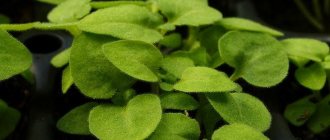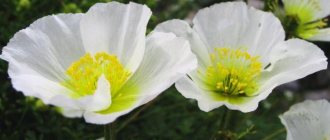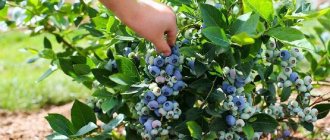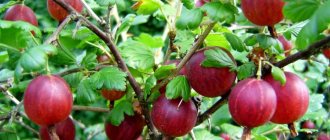What it looks like and where it grows
Lupine, or lupine (Lupinus), is an annual or perennial plant from the Legume family, up to 1-1.5 m tall. It has a tap root up to 2 m long and herbaceous or woody stems, erect or creeping. The leaves of the plant are complex, palmate, arranged in an alternate order on long petioles.
At the end of May and June, lupine bears lush apical inflorescences consisting of many buds. The color can be variegated or plain, pink, whitish, purple or blue. Each bud of the plant has a round or oval sail with halves strongly bent back and a two-lipped cup with a deep notch. After flowering, lupine bears fruit - leathery beans with a black, brown or cream color. Large seeds are collected in pubescent pods, which upon final ripening become brown and dry out.
If faded inflorescences are removed in a timely manner in August, lupine may bloom again
The plant is native to the Mediterranean and North America. Lupine is widespread in the Andes and Cordillera, Arizona, Texas, Mexico, and California. You can find the plant in Peru and Chile, as well as in African desert oases. In Russia, the perennial grows naturally in the European part of the country and is widely cultivated throughout the territory.
Biological features of “wolf beans”
The root core goes into the ground to a depth of 1 to 2 meters. Small tubers located on the roots are capable of accumulating nitrogen, providing nutrition to the plant in difficult weather conditions. The woody stems, tall and flexible, stand straight upright. The leaves are complex, finger-shaped, fleshy and elongated.
The flowers are borne on racemes and form leathery pods with smooth fruits. Lupine seeds are dicotyledonous beans that differ in size and color among different species of this plant.
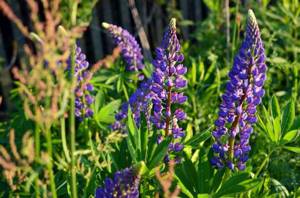
Chemical composition of lupine
The benefits and harms of lupine for humans are determined by the chemical composition of the plant. Perennial contains:
- fats and proteins;
- sugars and starch;
- alkaloids luralin, angustifoline and lupinine;
- amino acids;
- fiber;
- lupanin and hydroxylupanin;
- zinc and iron;
- vitamin PP;
- carotene;
- aspargine and glutamine;
- flavonoids;
- peptides;
- calcium.
The plant should be consumed with caution due to its high alkaloid content. For medicinal use, lupine is taken in minimal dosages.
Lupine care
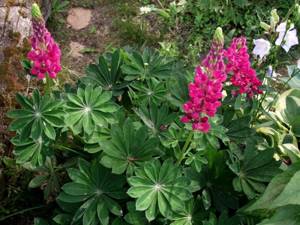
Two weeks after planting in the flowerbed, seedlings are fed with any complex mineral fertilizer intended for legumes. In the future, caring for the crop proceeds as follows:
- in the first two years, the lawn with flowers is weeded and loosened;
- the next day after watering, the soil around the bush must be hilled up;
- over time, the upper part of the root is exposed, it needs to be covered with earth;
- tall stems with flower stalks can break in windy weather; they are tied to supports;
- five-year-old bushes are dug up and new plants are planted in their place;
- water flower beds moderately in the evening;
- every spring lupins are fed with superphosphate (20 g per 1 sq. m) and calcium chloride (5 g per 1 sq. m);
- For the winter, perennial varieties are covered with sawdust and film.
Water the plants at the roots. Infusions of cut herbs, onions, and garlic are periodically added to the water. For preventive purposes, plants are sprayed with a solution of brilliant green with milk (10 - 15 drops per 2 liters of milk or whey). In arid areas, drip irrigation is used in beds and flower beds. In the evening, you can irrigate the bushes with a hose with a nozzle that disperses the stream of water.
Perennial varieties can be grown using mulching film. In this case, you won't have to do any weeding.
Useful properties of lupine
The lupine plant, when used correctly, has a beneficial effect on the human body. Namely:
- regulates blood sugar levels and helps with diabetes;
- improves the condition of diseases of the spleen and liver;
- relieves inflammation and pain from joint ailments;
- serves as a prevention of oncology and helps with existing tumors;
- strengthens the cardiovascular system and prevents the development of atherosclerosis;
- promotes recovery from neurological diseases;
- improves appetite and helps with nausea;
- strengthens the immune system and increases resistance to viruses and colds;
- protects the organs of vision and prevents the development of cataracts;
- strengthens nails and promotes hair growth;
- activates blood circulation and improves brain function.
You can use the valuable properties of lupine for abscesses, wounds and ulcers. Plant-based compositions disinfect damage and prevent the development of inflammation, and also accelerate tissue repair.
Care
Caring for perennial lupine is as follows:
- Periodic loosening of the soil while simultaneously removing weeds.
- Fertilize the soil under lupine sprouts with minerals next spring.
- Hilling up the plant as the root system is exposed.
- Renewal of planting after 3-4 years of flowering.
- Construction of supports, for example, from wire for tall plants.
- Trimming drying inflorescences to prolong the flowering of the plant.
So, a wonderful lupine plant will decorate your garden and improve the quality of the soil. Unpretentious, easy to care for. Even novice gardeners can easily cope with its cultivation.
Methods of preparation and use
Traditional medicine suggests preparing aqueous and alcoholic preparations for medicinal use based on lupine. The raw materials used are the green parts of the plant, as well as its seeds and oil, which can be purchased at the pharmacy.
Tincture
For liver diseases, colds and skin inflammations, a strong lupine tincture has a good effect. They do it like this:
- 100 g of dried herb is poured into 1 liter of vodka or dry white wine;
- put away under a lid in a dark and warm place for two days;
- After the expiration date, strain.
The resulting tincture of the lupine plant is taken orally for treatment, 5 ml three times a day.

You can use lupine tincture to disinfect lesions and spot treat ulcers on the skin.
Infusion, decoction
If you have poor appetite and liver damage, you can prepare an infusion using lupine seeds. They do it like this:
- the beans of the medicinal plant are ground to flour and 10 g are measured;
- mix the raw materials with 100 ml of table vinegar;
- add three large spoons of honey;
- add 10 g of pepper and rue;
- keep the mixture covered for two hours.
The finished product from the medicinal plant is taken 15 g twice a day.
A water infusion of lupine also has a good effect on digestion. The product is made according to the following algorithm:
- pour a large spoonful of plant grains with warm water and leave for five hours to swell;
- after the period has passed, drain the liquid;
- steam the seeds with a glass of fresh hot water;
- Boil for 15 minutes over low heat.
It is necessary to take the finished product based on the plant without straining, twice a day, in a glass.
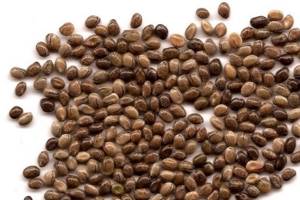
Decoctions and infusions of lupine beans stimulate the production of gastric juice and accelerate the breakdown of food
Ointment
For wounds, ulcers and abscesses, you can use a homemade ointment based on the plant. It is prepared according to the following algorithm:
- barley and lupine flour are mixed in equal quantities;
- pour boiling water over the powder in small volumes to obtain a viscous mass;
- wait until the mixture cools down a little.
We recommend reading: Burning bush (ash tree): where it grows in Russia, application
Warm ointment is applied to wounds and abscesses and covered with a bandage. It must be prepared again before each procedure.
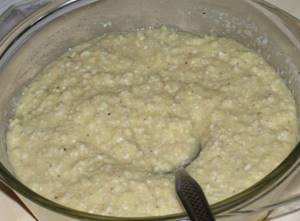
Compresses with lupine flour ointment are good for dermatitis
Planting lupine
For planting long-term lupins, it is recommended to choose areas that are well illuminated by the sun; however, partial shade is equally suitable. It is recommended to prepare the area for planting in advance. The plant does not withstand difficult soils; it is not recommended to grow the plant where the level of groundwater is extremely high.
The plant can be planted in spring or autumn. If you want to plant a flower in the fall, it is recommended to do this a month before the first cold weather begins. If you sow seeds in the spring, it is safer to do this after the snow begins to grow, approximately in mid-April.
If you plant flowers in the spring, you can already see them blooming in the summer. Only it will not be as rich as after the autumn planting.
Growing from lupine seeds
Lupine seeds are sown in open ground at the end of March, when the snow disappears, or in October. In the first case, the bushes provoke flowering in the next season in May-June, in the last - in August of the following year.
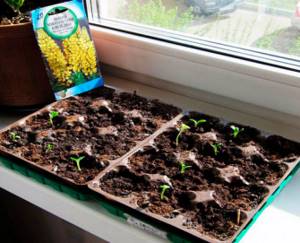
The technological process of planting does not present any great difficulty:
- The soil must be prepared in the autumn: I dig up the place to a depth of about thirty cm, add rottisite bait (dolomite flour, superphosphate, ash), clay, sand.
- Over the entire area, holes are dug at intervals of half a meter, no more than 2–2.5 cm.
- Seeds, which are initially cultivated with a 50% foundation solution, are sown gradually in holes and covered with a small cover of soil.
- In addition, the soil must be covered with fertilizer.
- The sprouts can be seen after 10–14 days. As a result of the appearance of 3–4 leaves on the stem, the bush is thinned out so that there is a distance of approximately 35–50 cm between nearby plantings or planted in a permanent place.
Growing seedlings
For this purpose, the soil is specialized in advance based on peat, sand and garden soil, taken in equal volumes. It is recommended to add powder from ground old lupine roots to the prepared soil. This action will increase the amount of nitrogen in the soil.

Growing plants in a greenhouse:
- the prepared soil is poured into a vessel, which must have a drainage layer so that there is no stagnation of water;
- seeds are sown to a depth of no more than 3 cm, a layer of peat is poured on top, approximately 1 cm;
- cover the container with a dampened cloth and move it to a warm place;
- after 10–14 days, the first shoots appear;
- After the sprouts develop 2–3 leaves, the seedlings are planted in a stable place.
The technology for growing seedlings takes approximately 20 days, for this reason it is necessary to calculate that there will be persistent warm weather outside before planting the seedlings in open ground.
Propagation using cuttings
For this purpose, basal rosettes are used, which arise in the spring from regenerating buds, which are located near the beginning of the trunk. The cuttings are cut off at the same time as the root collar and planted in sandy soil. After about 15–20 days, the bush will take root and be moved to a stable place.

Side shoots are also used as cuttings, which should be trimmed before flowering begins.
There is no need to divide the bush using the vegetative method during the propagation period: the main root can be very easily damaged, and it may not be reborn in another area. In August, root rosettes are used for cuttings. If you propagate by cuttings in the spring, the plant will be able to bloom in the fall.
Use of lupine in medicine
Traditional medicine uses the healing properties of lupine for inflammatory ailments, digestive disorders and skin diseases. Herbal remedies help well if used regularly according to recipes.
To strengthen the immune system
If you have weak immunity and a tendency to frequent colds, you can prepare a decoction of the plant’s seeds. They do it like this:
- a handful of lupine grains are soaked for five hours in warm water to soften them;
- pour 200 m of fresh liquid into the raw material and boil for several minutes after boiling;
- cool the product until warm.
You need to take a decoction of the plant's beans twice a day along with the sediment. The drink will not only increase resistance to colds, but will also have a beneficial effect on digestion.
For ulcers and wounds
For neurological inflammations, compresses based on green lupine seeds have a good effect. The medicinal mixture is made as follows:
- a handful of grains is poured with a small amount of water and boiled until softened;
- Using a masher, carefully grind the seeds.
The resulting homogeneous mass is applied to the sore spot in an even layer and covered with a bandage. You need to leave the compress from the beans of the plant for 1-2 hours, and carry out the procedure every evening until the condition improves.
For inflammation of the sciatic nerve
A compress with plant grains alleviates the condition of neurological inflammatory diseases. For external use, prepare the following mixture:
- 30 g of lupine seeds are ground into dry flour;
- mixed with three large spoons of honey;
- add 20 g of dry black wolf bast powder;
- Pour the components into 100 ml of boiling water.
The product is stirred until smooth, wait until it cools slightly, and apply to the sore spot in the form of lotions and compresses.
For skin rashes
The anti-inflammatory and cleansing properties of lupine help well with problematic epidermis. It is recommended to prepare the following infusion from a beneficial plant:
- two large spoons of dry lupine grass are poured with a glass of boiling water;
- leave covered for two hours;
- filter through cheesecloth.
The resulting product is used for washing in the mornings and evenings for two months. Lupine regulates skin oiliness and reduces the number of breakouts.
For abscesses
Medicinal lupine has an antiseptic and healing effect on ulcers and abscesses. The following ointment is prepared for treatment:
- dry lupine seeds are ground into powder in a volume of 10 g;
- mixed with 15 g of honey and 30 ml of vinegar 9%;
- bring the product to a homogeneous state.
The finished drug is consumed three times a day, using a large spoon.
Important! Internal use of lupine is combined with external use; the mass must also be applied directly to sore spots.
For heart ailments
Lupine seed oil has a beneficial effect on blood vessels and helps strengthen the cardiac system. A wine tincture is prepared for therapy:
- 40 ml of lupine oil is mixed with 30 g of natural honey;
- pour the ingredients with 100 ml of dry red wine;
- Stir well and leave to brew for a couple of hours.
The finished product is taken twice a day, 50 ml, without filtering. Since the drug is alcoholic, it is very important to follow the dosage during treatment.

Lupine tincture in wine with honey and vinegar improves blood composition and prevents anemia
For hair loss
The healing properties of lupine have a good effect on weakened hair that is prone to loss. To strengthen curls, prepare the following remedy:
- 50 g of dried flowers and leaves of the plant are mixed with 30 g of crushed willow bark;
- add two large spoons of dried adiantum;
- add 1 liter of water to the plant material;
- bring to a boil and cook over low heat for another ten minutes.
The strained product is cooled to a warm temperature and filtered. It must be used every time after hygiene procedures to rinse curls.
For staphylococcal infection
The beneficial properties of lupine are used to get rid of Staphylococcus aureus. Traditional medicine recommends the following collection:
- 250 g of dry leaves of the plant are mixed with an equal amount of burdock;
- add 300 g of yarrow;
- add 150 g of dried nettle, plantain and sweet clover;
- add chamomile and calendula flowers in a volume of 50 g;
- mixed with 100 g of rose hips and 50 g of horsetail and dandelion roots;
- measure out 100 g of multi-component collection;
- pour 1 liter of water.
The product is brought to a boil on the stove and simmered for about eight minutes, and then turned off and filtered. A herbal preparation from several plants is consumed three times a day, using a large spoon.
For heavy periods
For painful and excessively heavy periods in women, you can use homemade ointment with lupine flour. They do it like this:
- 10 g of ground seeds are mixed with 15 g of honey;
- bring the components to a homogeneous state.
We recommend reading: Birch polypore: beneficial properties, use in folk medicine
The resulting ointment from a medicinal plant is used to treat the lower abdomen and navel area, and also take the product orally three times a day, 5 g.
Important! Consuming lupine with honey is beneficial in the complex treatment of worms.
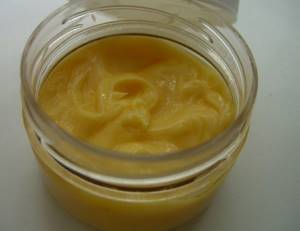
Lupine flour in combination with honey has an analgesic effect and reduces bleeding
For premature skin aging
The medicinal plant lupine has a good effect on the skin and helps prevent its premature aging. To rejuvenate and refresh the epidermis, prepare the following infusion:
- 50 g of lupine seeds are mixed with an equal amount of starch and fava beans;
- add 50 g of melon seeds and chickpeas;
- pour 500 ml of hot water into the raw material;
- leave for six hours under the lid to infuse.
The finished product based on a beneficial plant is filtered and used for daily washing in the morning and evening. After using the infusion, the skin quickly acquires elasticity and a healthy color.
Lupine is a promising forage crop. Economic significance
Currently, in the livestock industry there is an acute problem of shortage of protein feed in the diet of animals. One solution to this problem is to grow a leguminous crop such as lupine, which is a highly concentrated protein crop (up to 40% protein). This plant has the property of balancing proteins, being a scarce raw material for the feed industry, poultry farming and livestock farming. This agricultural crop is considered very young, and its first grain fodder variety appeared in the Register of Varieties of the Russian Federation only in 1998.
Currently, there are only two crops with such a high protein concentration - soybean and lupine. Soybeans, as you know, are more suitable for warm, monsoon climates (America, in the Russian Federation - Primorsky Krai), but the territory of Russia has rather small climatic areas that are suitable for cultivating soybeans, therefore in Russia the optimal high-protein crop is lupine , which is sometimes called northern soy.
Economic benefits when growing lupine.
Economic advantages consist of the following components:
1. Growing lupine, in comparison with soybeans, is more economically profitable. There is no need to apply mineral fertilizers to lupine, since it has a very powerful biotic, environment-stabilizing potential and is capable of accumulating nitrogen from the air in large quantities, extracting phosphorus from the soil, and at the same time is not demanding of potassium. Thus, lupine does not react to mineral fertilizers, unlike soybeans.
2. In fields where lupine was the predecessor, the yield of grains (for example, winter wheat) is much higher, and, as a rule, increases by a whole ton due to the fact that lupine leaves behind a large amount of biologically accumulated nitrogen in the soil.
3. At the same protein concentration, the yield of lupine is 1.5-2 times higher than soybean.
4. Cultivated varieties are mainly represented by three species, which have their own characteristics and can occupy their own geographic niches in the fields of Russia, unlike soybeans.
5. Lupine is a fairly unpretentious crop and the same set of equipment that is used for cultivating grain crops is quite suitable for its cultivation.
6. Lupine is not picky about moisture. In particular, for hot, arid climates, a type of lupine called white lupine
, which is 1.5-2 times more productive than other types of lupine. This species is recommended by specialists of the All-Russian Research Institute of Lupine for cultivation in the territories of Samara, Saratov and other regions.
7. In dry years, the yield of white lupine is at least 2.5 t/ha. In a normal year, its yield potential is at least 4 t/ha without fertilization.
Comparative table of soybean, white lupine and pea crops
In addition to the high advantages of lupine grain, its green mass in protein concentration is close in comparison with alfalfa, and in general, in terms of biological value, the green mass of lupine is higher than that of alfalfa.
The only limiting factor when using lupine in animal diets is the content of alkaloids in it, which can have a toxic effect. However, all modern recommended varieties for cultivation are low-alkoloid, which allows the use of lupine feed in quantities that can balance the protein nutrition of the diet without danger.
Many agricultural enterprises, having assessed the benefits of growing this leguminous crop, decide to replace peas and sugar beets with white lupine.
Use in cooking
For culinary purposes, mainly flour obtained from lupine seeds is used. Despite its numerous valuable properties, it does not impair the taste of products, nor does it affect their smell or consistency. The plant contains many amino acids and plant fiber, which further increases the value of flour prepared from it. Bakery products made using lupine grains can be stored for up to a week.
The plant in Japan and other Asian countries is added to soy sauce and tofu. In Europe, you can find lupine in diet ice cream - the delicacy is low in calories and at the same time very soft and pleasant in consistency. In South American countries, plant beans are consumed fried. They are no less popular than potatoes and corn.
Growing lupine flowers in open ground
The plant is most often propagated by seeds. Often, if lupine has already been noticed in the garden plot, then it is not worth planting it on purpose.
Including with constant cutting of inflorescences, since a certain amount of seeds definitely ends up in the ground.
However, varietal species split with any subsequent generation. The color of the petals will be dominated by blue and lilac shades, as a result of which decorative types are grown only from selected breeding types of seeds.
Growing seedlings:
- The seeds must first be scarified, and then mixed with ground tubers. Since they can become enriched with nitrogen-fixing microbes and will begin to develop more actively.
- Following this, the planting elements are measuredly distributed to a depth of 3 cm.
- And after 2 weeks, sprouts are noticed.
- When the main part of the seedlings grows 3 leaves, it needs to be planted in an open growing area. Later, the main root will become curved, which can negatively affect the rise.
- To improve the properties of the soil, the plant can be transplanted immediately into the soil itself.
- This is done at the end of autumn.
- First, special grooves are prepared, retreating 30 cm.
- The seeds are also placed in them at a certain distance of up to 15 cm.
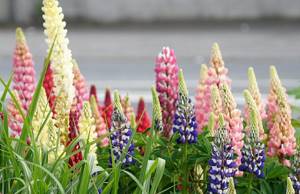
Contraindications to the use of lupine
The effect of lupine on the body is not always positive. The herb contains a large number of toxic alkaloids that can cause harm. It is necessary to refuse to use the plant:
- for individual allergies;
- during pregnancy;
- during breastfeeding;
- for severe diseases of the central nervous system;
- with cirrhosis of the liver.
Lupine-based products are not offered to children and adolescents. During therapy with a medicinal plant, it is necessary to observe small dosages and take breaks in treatment. Too much use of the herb leads to damage to the liver and nervous system, and with a single overdose of lupine, nausea, diarrhea and headaches can develop.
Collection and preparation
Any part of the plant has medicinal value. Lupine is collected throughout the warm season. At the beginning of summer, buds and leaves are harvested, closer to August, the stems are cut, and with the onset of late autumn, the roots are dug up.
Lupine grass should be dried in the fresh air under a canopy or in a warm room away from sunlight. You are also allowed to use the oven, but it must be heated to a maximum of 50 °C. When the temperature rises, valuable substances in lupine are destroyed - primarily vitamin C and organic acids.
The dried plant should be stored in paper bags, fabric bags or cardboard boxes in a dark cabinet with low humidity. From time to time, it is recommended to stir the workpieces to prevent mold from appearing.
Attention! The lupine plant should be collected for medicinal use only in ecologically clean places away from roads and industrial facilities.
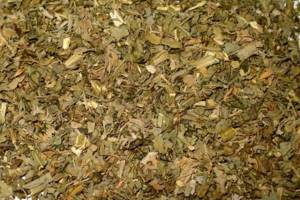
Raw materials of medicinal lupine retain valuable properties for up to a year
As for the seeds, they are harvested after final ripening - the pods should dry out and acquire a brownish-brown color. Plant beans for medicinal use are also dried in the fresh air, in a room or in an oven at a temperature not exceeding 50 °C. For storage, seeds are stored in a clean plastic or glass container under an airtight lid.
The most common annual varieties
Drought-tolerant plants are sensitive to sunlight. They love illuminated areas and, even on cloudy, cloudy days, turn their flowers towards the sun. At night they lower their leaves and raise them again in the morning. Annual lupins are planted with seeds before winter or early spring.
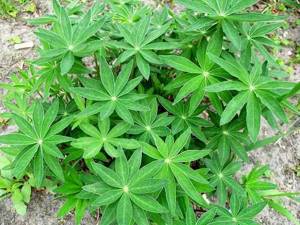
It creates lush areas of color in lawns and combines well with other flowers. On very depleted soils, mineral fertilizers are applied. Planting and caring for lupine is not difficult. This is a frost-resistant plant, hardy and strong, but does not tolerate organic fertilizers and excess moisture.

Lime also harms the plant. Seeds are sown immediately in a permanent place, without seedlings, at a distance of 5-7 cm between them.
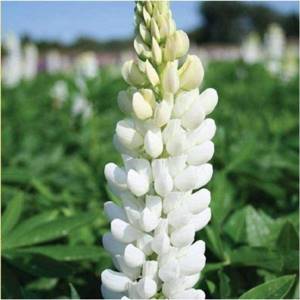
The magical properties of the lupine flower
There are many popular beliefs associated with this beautiful and useful plant. It is credited with strong magical properties; it is believed that lupine bestows attractiveness and health, maintains confidence and ignites passion. White-flowering varieties contribute to successful marriage and family happiness.
At the same time, the plant also has negative properties in folk superstitions. In the Middle Ages, it was believed that lupine juice could turn a person into a werewolf, and also helped to cause damage and was used for contact with evil spirits. At the same time, plant beans were used even hundreds of years ago for protective spells, to cleanse negative energy and for meditation.
Care after flowering, preparation for winter
To prevent lupine from starting to spread uncontrollably throughout the garden plot, the flower stalks along with the fruits are cut out with pruning shears immediately after flowering. Only those bushes from which seeds are needed are left. Plants grown from beans do not always retain the external qualities of the parent bush; flowers on new bushes may have a completely different shade.
Closer to October, the leaves and central stem are cut out. The soil around the flower is loosened. The root collar is covered with a layer of sawdust or any other mulch.
